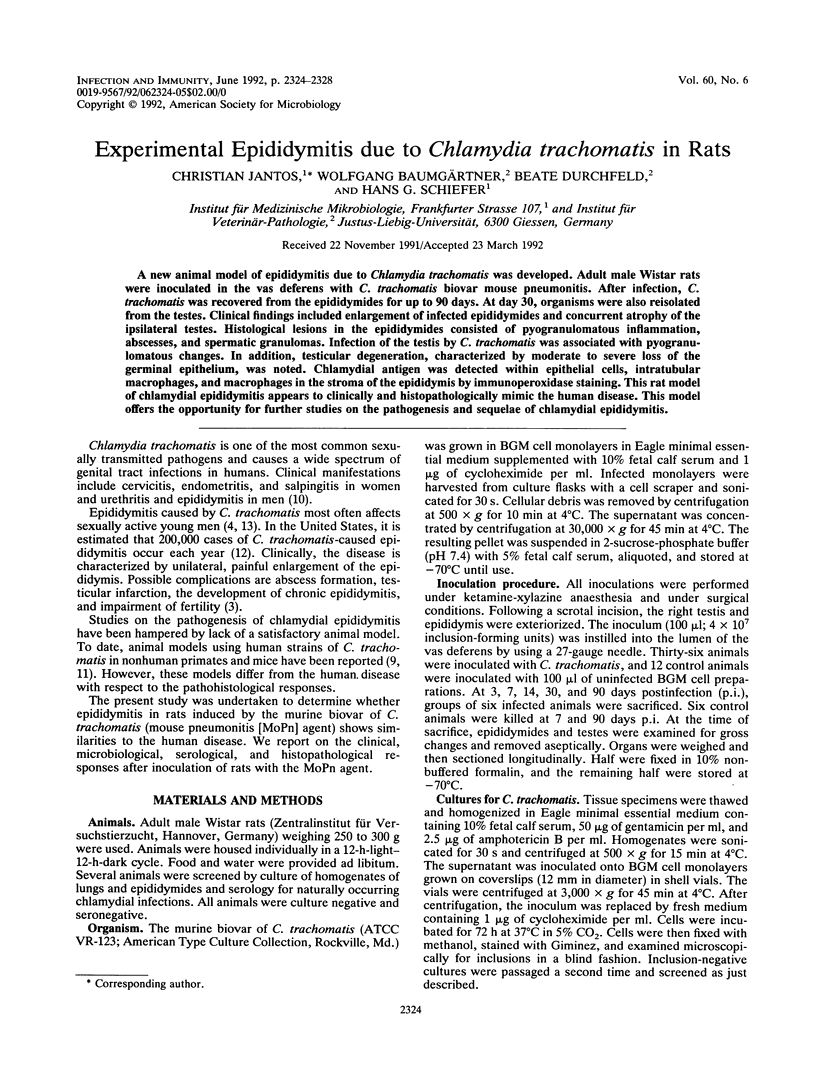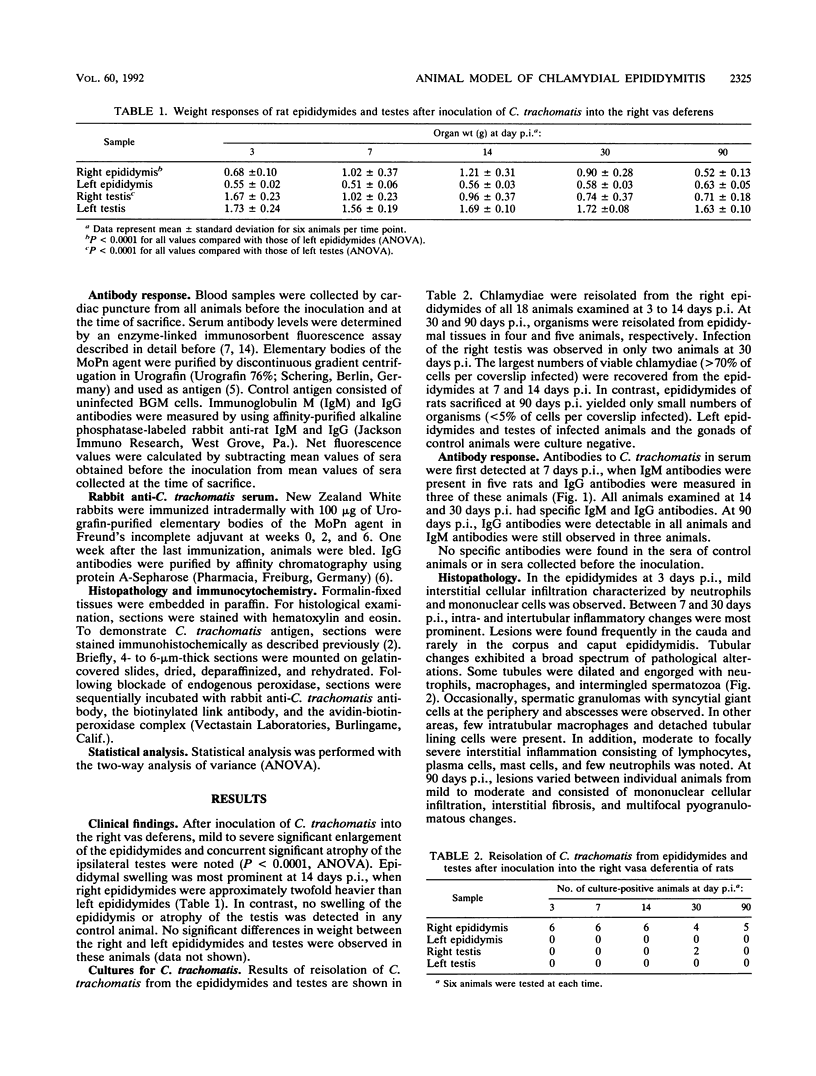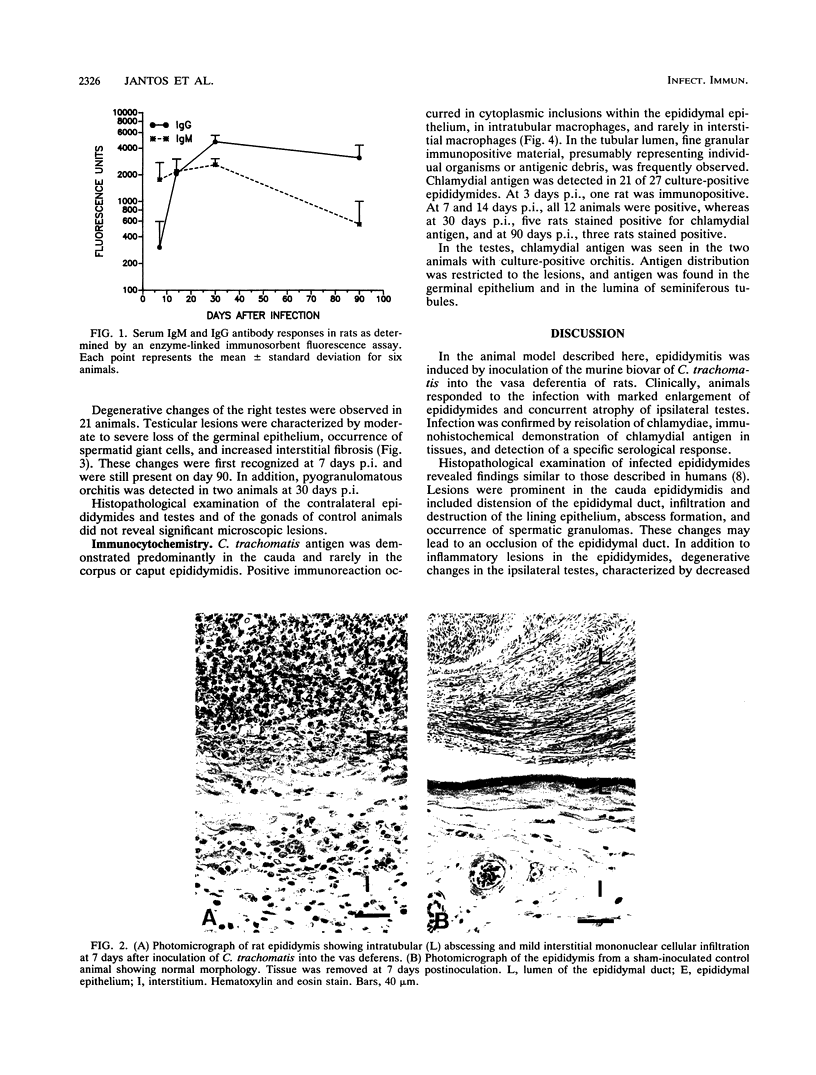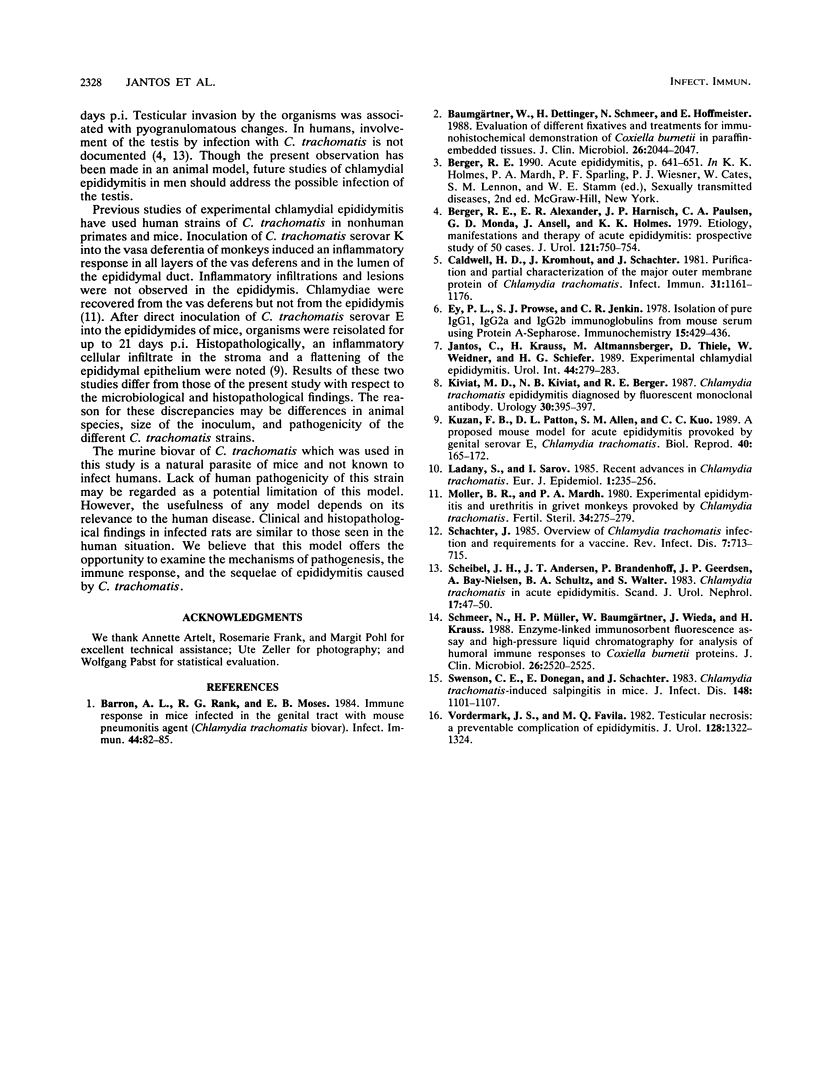Abstract
A new animal model of epididymitis due to Chlamydia trachomatis was developed. Adult male Wistar rats were inoculated in the vas deferens with C. trachomatis biovar mouse pneumonitis. After infection, C. trachomatis was recovered from the epididymides for up to 90 days. At day 30, organisms were also reisolated from the testes. Clinical findings included enlargement of infected epididymides and concurrent atrophy of the ipsilateral testes. Histological lesions in the epididymides consisted of pyogranulomatous inflammation, abscesses, and spermatic granulomas. Infection of the testis by C. trachomatis was associated with pyogranulomatous changes. In addition, testicular degeneration, characterized by moderate to severe loss of the germinal epithelium, was noted. Chlamydial antigen was detected within epithelial cells, intratubular macrophages, and macrophages in the stroma of the epididymis by immunoperoxidase staining. This rat model of chlamydial epididymitis appears to clinically and histopathologically mimic the human disease. This model offers the opportunity for further studies on the pathogenesis and sequelae of chlamydial epididymitis.
Full text
PDF




Images in this article
Selected References
These references are in PubMed. This may not be the complete list of references from this article.
- Barron A. L., Rank R. G., Moses E. B. Immune response in mice infected in the genital tract with mouse pneumonitis agent (Chlamydia trachomatis biovar). Infect Immun. 1984 Apr;44(1):82–85. doi: 10.1128/iai.44.1.82-85.1984. [DOI] [PMC free article] [PubMed] [Google Scholar]
- Baumgärtner W., Dettinger H., Schmeer N., Hoffmeister E. Evaluation of different fixatives and treatments for immunohistochemical demonstration of Coxiella burnetti in paraffin-embedded tissues. J Clin Microbiol. 1988 Oct;26(10):2044–2047. doi: 10.1128/jcm.26.10.2044-2047.1988. [DOI] [PMC free article] [PubMed] [Google Scholar]
- Berger R. E., Alexander E. R., Harnisch J. P., Paulsen C. A., Monda G. D., Ansell J., Holmes K. K. Etiology, manifestations and therapy of acute epididymitis: prospective study of 50 cases. J Urol. 1979 Jun;121(6):750–754. doi: 10.1016/s0022-5347(17)56978-5. [DOI] [PubMed] [Google Scholar]
- Caldwell H. D., Kromhout J., Schachter J. Purification and partial characterization of the major outer membrane protein of Chlamydia trachomatis. Infect Immun. 1981 Mar;31(3):1161–1176. doi: 10.1128/iai.31.3.1161-1176.1981. [DOI] [PMC free article] [PubMed] [Google Scholar]
- Ey P. L., Prowse S. J., Jenkin C. R. Isolation of pure IgG1, IgG2a and IgG2b immunoglobulins from mouse serum using protein A-sepharose. Immunochemistry. 1978 Jul;15(7):429–436. doi: 10.1016/0161-5890(78)90070-6. [DOI] [PubMed] [Google Scholar]
- Jantos C., Krauss H., Altmannsberger M., Thiele D., Weidner W., Schiefer H. G. Experimental chlamydial epididymitis. Urol Int. 1989;44(5):279–283. doi: 10.1159/000281523. [DOI] [PubMed] [Google Scholar]
- Kiviat M. D., Kiviat N. B., Berger R. E. Chlamydia trachomatis epididymitis diagnosed by fluorescent monoclonal antibody. Urology. 1987 Oct;30(4):395–397. doi: 10.1016/0090-4295(87)90313-x. [DOI] [PubMed] [Google Scholar]
- Kuzan F. B., Patton D. L., Allen S. M., Kuo C. C. A proposed mouse model for acute epididymitis provoked by genital serovar E, Chlamydia trachomatis. Biol Reprod. 1989 Jan;40(1):165–172. doi: 10.1095/biolreprod40.1.165. [DOI] [PubMed] [Google Scholar]
- Ladany S., Sarov I. Recent advances in Chlamydia trachomatis. Eur J Epidemiol. 1985 Dec;1(4):235–256. doi: 10.1007/BF00237099. [DOI] [PubMed] [Google Scholar]
- Møller B. R., Märdh P. A. Experimental epididymitis and urethritis in grivet monkeys provoked by Chlamydia trachomatis. Fertil Steril. 1980 Sep;34(3):275–279. doi: 10.1016/s0015-0282(16)44962-9. [DOI] [PubMed] [Google Scholar]
- Schachter J. Overview of Chlamydia trachomatis infection and the requirements for a vaccine. Rev Infect Dis. 1985 Nov-Dec;7(6):713–716. doi: 10.1093/clinids/7.6.713. [DOI] [PubMed] [Google Scholar]
- Scheibel J. H., Andersen J. T., Brandenhoff P., Geerdsen J. P., Bay-Nielsen A., Schultz B. A., Walter S. Chlamydia trachomatis in acute epididymitis. Scand J Urol Nephrol. 1983;17(1):47–50. doi: 10.3109/00365598309179780. [DOI] [PubMed] [Google Scholar]
- Schmeer N., Müller H. P., Baumgärtner W., Wieda J., Krauss H. Enzyme-linked immunosorbent fluorescence assay and high-pressure liquid chromatography for analysis of humoral immune responses to Coxiella burnetti proteins. J Clin Microbiol. 1988 Dec;26(12):2520–2525. doi: 10.1128/jcm.26.12.2520-2525.1988. [DOI] [PMC free article] [PubMed] [Google Scholar]
- Swenson C. E., Donegan E., Schachter J. Chlamydia trachomatis-induced salpingitis in mice. J Infect Dis. 1983 Dec;148(6):1101–1107. doi: 10.1093/infdis/148.6.1101. [DOI] [PubMed] [Google Scholar]
- Vordermark J. S., 2nd, Favila M. Q. Testicular necrosis: a preventable complication of epididymitis. J Urol. 1982 Dec;128(6):1322–1324. doi: 10.1016/s0022-5347(17)53482-5. [DOI] [PubMed] [Google Scholar]





